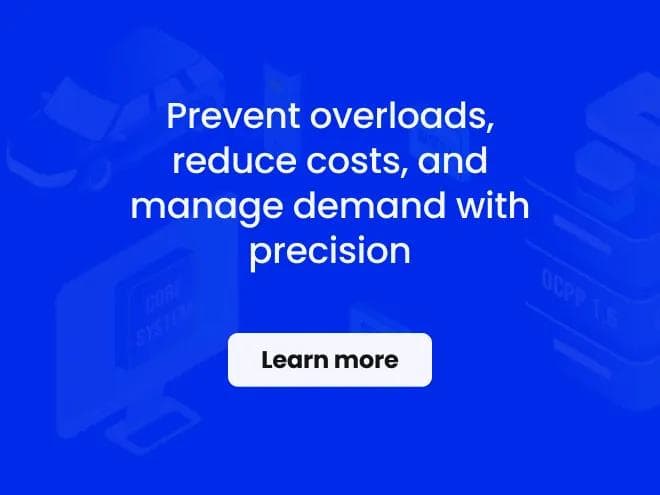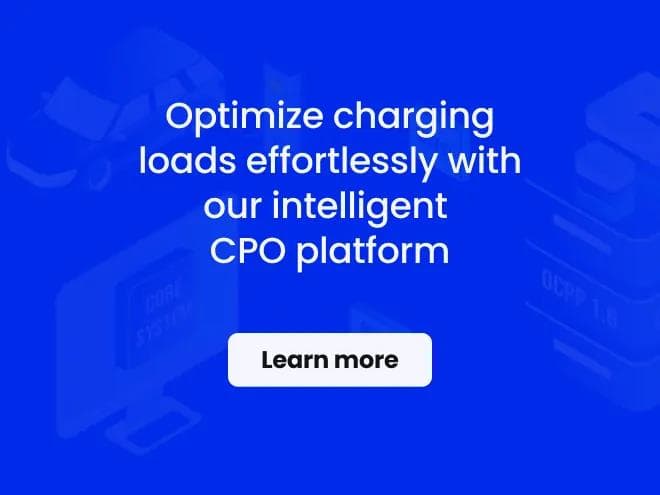As electric vehicle adoption surges, charge point operators (CPOs) and fleet managers face a tough reality: the power capacity at most sites isn’t ready for a multi-charger world. Upgrading electrical infrastructure is expensive, time-consuming, and often unnecessary if you know how to optimize existing capacity.
That’s where EV load management comes in.
An effective EV load management system dynamically distributes available power across charging stations based on real-time demand, ensuring optimal performance without overloading the grid or the site's electrical limits.
In this article, we’ll break down EV load management, why it matters, and how it can help you avoid infrastructure headaches while scaling your charging operations profitably.
What is EV load management?
EV load management refers to the intelligent distribution of electrical power across multiple EV chargers within a site with limited or fixed energy capacity. Instead of delivering full power to every charger at all times, regardless of usage, load management systems dynamically allocate available energy based on real-time demand, priority rules, or preconfigured schedules.
The problem EV load management solves
Most charging locations aren’t wired to support the simultaneous peak operation of every installed charger. Without load management, operators must either:
- Limit the number of active sessions,
- Accept slow charging speeds and a poor user experience, or
- Pay for costly electrical upgrades.
EV load management eliminates this trade-off by using software and sometimes hardware logic to efficiently spread available capacity across chargers, ensuring safe, uninterrupted operation while maximizing infrastructure ROI within an EV charging business model.
Key modes of load management
- Static load management: Predefined limits on each charger. Simple but inflexible.
- Dynamic load management (DLM): Real-time adjustment based on live usage, connected vehicle demand, and site capacity.
- Scheduled load management: Charging behavior is shaped by time-based rules or grid signals (e.g., avoiding peak hours).
The cost challenge of scaling EV charging infrastructure
Installing more EV chargers is only part of the equation. Without enough power on-site, even the most advanced hardware can’t perform as intended. The real obstacle is the electrical capacity, not the number of charging stations. And that’s where many CPOs and fleet operators hit a wall.
The EV infrastructure bottleneck
Most commercial or residential locations have a fixed electrical capacity, often sized for existing building needs, not high-power EV charging. Trying to add multiple 11kW or 22kW chargers can easily overwhelm this capacity. The typical response? Costly electrical upgrades, which can include:
- Transformer or panel replacements,
- Trenching and rewiring,
- Utility coordination and permitting delays.
These upgrades are expensive and also slow down time-to-market for your charging services.
The demand charge trap
In many regions, utility providers impose demand charges based on your highest peak power usage during a billing cycle. If multiple EVs begin charging at full speed simultaneously, even briefly, you could be billed at a much higher rate, regardless of average energy use.
Without load management, your charging site is vulnerable to unpredictable cost spikes driven by short-lived power surges.
Overprovisioning as a false solution
Some operators attempt to “future-proof” by drastically overbuilding their infrastructure to support peak usage that may never come. This leads to wasted capital and underutilized assets, especially when the load could have been managed dynamically.
How load management systems solve these problems
A well-designed EV load management system allows operators to maximize existing power capacity without overspending on infrastructure. By intelligently controlling how and when each charger draws electricity, these systems ensure efficient, safe, and cost-effective use of limited power.
Real-time power distribution
Instead of letting every charger operate at full capacity regardless of grid limits, load management dynamically adjusts power levels across chargers in real time. For example:
If three EVs are charging at once on a limited 50 kW line, the system might allocate 15 kW to each and leave 5 kW as a buffer.As vehicles finish charging or reduce demand, the system reallocates power to the remaining sessions.
This continuous balancing prevents overloads and allows more chargers to operate within a fixed capacity.
Prioritization rules
Modern systems don’t just split power evenly; they can follow smart rules based on:
- Time-to-departure (e.g., prioritizing taxis or deliveries),
- Battery state-of-charge (SoC),
- User type (e.g., public vs. subscribed fleet),
- Tariff periods or renewable availability.
This allows charging behavior to reflect business logic or user expectations, not just raw power availability.
Infrastructure deferral
With dynamic allocation in place, operators can:
- Add more chargers without upgrading transformers or panels,
- Expand incrementally based on actual usage trends,
- Delay or eliminate grid upgrade projects..
For most sites, this translates into significant cost savings often enough to pay for the software layer many times over.
Exemplary scenario: Managing 10 chargers on a constrained site
Let’s imagine a fleet operator managing a last-mile delivery depot. The site has 10 EV chargers installed, each rated at 11 kW, but the building’s existing electrical infrastructure only allows for 50 kW total capacity to be allocated to EV charging.
Without load management
- If five or more vehicles plug in simultaneously and request full power, the system overloads.
- To prevent this, the operator either disables some chargers or schedules usage manually.
- Upgrading the infrastructure to accommodate all 10 chargers at full power would cost upwards of €40,000–€60,000, not including downtime or permitting delays.
With EV load management
- The load management system detects how many vehicles are connected and how much power is available.
- It dynamically distributes the available 50 kW across all active sessions. For example, 10 kW each if five are charging, or 5 kW each if all 10 are in use.
- If a high-priority vehicle (e.g., one scheduled to depart soon) plugs in, the system allocates more power to it temporarily.
- As vehicles complete charging, the available power is reallocated, without manual intervention or hardware strain.
The result
- No costly grid upgrades.
- Full use of all chargers, even under constrained capacity.
- Improved fleet uptime and predictable energy costs.
This kind of scenario plays out across depots, apartment buildings, commercial parking lots, and public charging hubs, anywhere capacity is limited but demand is growing.
Operational, user, and grid-level benefits of EV load management
While the ability to avoid costly infrastructure upgrades is a strong incentive, EV load management offers far more than just financial savings. It unlocks flexibility, resilience, and long-term scalability for operators who want to stay ahead of user expectations and grid demands.
1. Operational efficiency
Load management systems reduce the need for manual intervention and reactive troubleshooting. With intelligent automation in place:
- Charging sessions are balanced in real time without technician input.
- Capacity is fully utilized across chargers, even during peak hours.
- Software rules (e.g., prioritization, queuing) reflect real-world fleet or business logic.
This leads to smoother operations and fewer disruptions for both staff and users.
2. Improved charging experience
For drivers, whether public users or fleet employees, load management translates into more predictable and reliable charging:
- Chargers are less likely to be disabled due to power constraints.
- Queues are minimized with dynamic prioritization.
- Charging speeds may adapt based on urgency or reservation settings, improving perceived fairness and trust in the system.
Even with constrained power, users experience consistent service quality.
3. Grid responsiveness and sustainability
Modern load management systems can integrate with external signals such as:
- Dynamic pricing from utility providers,
- Demand response events (e.g., grid strain mitigation),
- Renewable energy availability from solar or storage systems.
This enables smart load shifting, where EV charging is timed or throttled based on grid conditions or carbon intensity. Over time, this supports:
- Reduced grid congestion,
- Lower carbon emissions,
- Eligibility for utility incentives or energy market participation.
4. Scalability without chaos
As networks grow, unmanaged sites become increasingly complex and risky. Load management systems provide a centralized, scalable framework that allows operators to:
- Expand their charger footprint without redesigning electrical systems,
- Enforce consistent logic across diverse sites,
- Monitor performance and energy use from a unified backend.
Why CPOs Need a Software-First Load Management Approach
Hardware-based solutions for EV load management, such as local controllers or fixed-current splitters, may work in small, static setups. But for any operator looking to scale, adapt, or integrate with evolving systems, software-based load management is the only viable path forward.
1. Flexibility across hardware
A software-first architecture allows operators to:
- Work with a mix of charger brands and models,
- Switch or upgrade hardware without rewriting core logic,
- Stay aligned with open protocols like OCPP 1.6 or 2.0.1 for interoperability.
This reduces vendor lock-in and futureproofs your infrastructure as standards evolve.
2. Smarter, data-driven decision making
Software-based systems can pull in real-time data from multiple sources:
- Charger telemetry,
- Energy meters,
- Battery SoC from vehicles (where available),
- User profiles and usage patterns.
This enables more intelligent power allocation, predictive prioritization, and deeper analytics over time, benefits that hardware-based logic simply can’t deliver.
3. Seamless integration with backend systems
Load management doesn’t live in a vacuum. It needs to interface with:
- Charging session management tools,
- Payment and pricing engines,
- Fleet dispatch systems,
- Energy or battery management systems (EMS/BMS).
Software-driven systems expose APIs and modular logic that can plug into the rest of your ecosystem; something local hardware logic struggles to support at scale.
4. Cloud control with local fallbacks
Modern software-first platforms often combine cloud intelligence with edge-level safety mechanisms:
- Global control logic lives in the backend for coordinated optimization.
- On-site fallback rules ensure chargers still function safely if connectivity drops.
This hybrid model offers the best of both worlds: centralized control with local resilience.
Load management is the practical advantage
Power limitations are a daily constraint for charge point operators and fleet managers. When you’re trying to expand charging capacity without triggering expensive infrastructure upgrades, EV load management becomes one of the most practical tools you can deploy.
With a reliable load management system in place, you can:
- Make full use of existing electrical capacity,
- Avoid demand spikes and utility penalties,
- Prioritize charging based on real needs, not guesswork,
- Expand your charging network with less risk and lower cost.
Solidstudio’s CPO platform includes built-in support for EV load management, giving operators full control over power distribution across their charging stations. Our backend enables dynamic load balancing, custom prioritization logic, and seamless integration with the rest of your charging infrastructure, all without locking you into proprietary hardware.
If you’re expanding your EV charging network and need to keep infrastructure costs under control, intelligent load management should be one of your first steps.
Let’s talk, book a consultation now!



